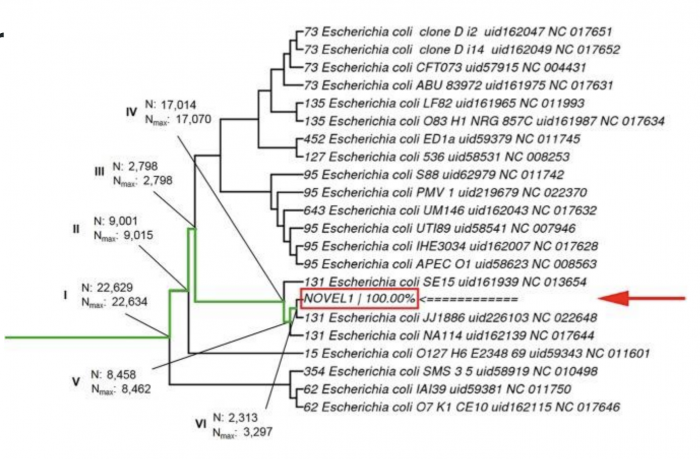Team II Webserver Group
Introduction
Background And Goal
We got our raw data from Dr. David S. Weiss' lab (ARC, Division of Infectious Diseases). They provided us with a sample ID numbers and we downloaded 258 pair-end raw reads sequences of Klebsiella spp,sequenced by illumina MiSeq. from NCBI SRA database. The goal of the class was to provide an insight on the major issue of antibiotic resistance. Klebsiella is a genus of nonmotile, Gram-negative, oxidase-negative, rod-shaped bacteria with a prominent polysaccharide-based capsule. Klebsiella species are found everywhere in nature. The members of the genus Klebsiella are a part of the human and animal's normal flora in the nose, mouth and intestines. The species of Klebsiella are all gram-negative and non-motile. Some of Klebsiella types are: K.granulomatis, K. oxytoca, K. michiganensis and K. pneumoniae (type-species: K. p. subsp. ozaenae, K. p. subsp. pneumoniae, K. p. subsp. rhinoscleromatis).
Our job as the Web Server Team was to provide the following:-
1. An easy-to-use tool to help distinguish between Klebsiella phenotypes, by implementing the work of the comparative genomics group.
2. A robust and easy-to-use web-based de-novo assembly tool.
3. A feature to visualize and download the results of the 258 genomes.
Here, we build a web server that ideally predicts a phenotype based on the genetic information it is given.
Design Principles
1. Minimalistic
2. Mobile Friendly
3. Short Load Time
4. Contrasting Colors
Functionalities Offered
Genome Assembly
Users will have the option of uploading either an assembled genome or short-reads from NGS methods. If short-reads are provided, a de novo assembly will be performed using the assembler Skesa. The resulting assembly will be available for download and will be used for downstream processes.
Strain and Species Identification
Strain identification is performed using k-mer based approaches in StrainSeeker. Each user-provided input sample is reduced to a pool of unique k-mers that is compared to k-mer pools from samples in the NCBI sequence database. The observed and expected k-mer pool overlaps between user-provided samples and NCBI-samples are used to taxonomically place samples with unknown strain identity.
Antibiotic-resistance Profiling
Each user-provided sample will be compared to the Comprehensive Antibiotic Resistance Database (CARD) using the toolkit RGI. RGI discovers high-confidence homologues of known antibiotic-resistance genes using Diamond homology searches. RGI also incorporates SNP models to predict genetic variants that are likely to confer new antibiotic resistances. The entire antibiotic profile of each strain is visualized in a wheel-chart (provided by RGI) that allows the user to explore result by drug class, mechanism of resistance, and antibiotic target.
Virulence Factor Profiling
Each user-provided sample will be blasted against the Virulence Factor Database (VFDB) to identify homologues of known virulence factors. A non-redundant blast output (outfmt 6) will be provided for download by the user.
Tools
Skesa
Skesa is the most recent tool in our list and is currently used by NCBI. Information about the algorithm is currently unavailable. . De novo sequencing refers to sequencing a novel genome where there is no reference sequence available for alignment. Sequence reads are assembled as contigs, and the coverage quality of de novo sequence data depends on the size and continuity of the contigs (ie, the number of gaps in the data).
To compare the performance of the above tools, we use Quast.
StrainSeeker
StrainSeeker is a program for detecting bacterial strains from raw sequencing reads. Compared to other similar programs, it offers the following advantages:
1. Fully customizable database - use your own strains of interest or download our database
2. Detect novel strains that are related to strains in the database
3. Quickly handle large amounts of data
4. Results given all the way down to the strain level!
Input
Fastq or Fasta sample
Output tree

CARD AND RGI
The Comprehensive Antibiotic Resistance Database ("CARD") provides data, models, and algorithms relating to the molecular basis of antimicrobial resistance.
- The CARD provides curated reference sequences and SNPs organized via the Antibiotic Resistance Ontology ("ARO"). These data can be browsed on the website or downloaded in a number of formats.
- These data are additionally associated with detection models, in the form of curated homology cut-offs and SNP maps, for prediction of resistome from molecular sequences.
- These models can be downloaded or can be used for analysis of genome sequences using the Resistance Gene Identifier ("RGI"), either online or as a stand-alone tool.
The algorithm used is as follows:-
- Open Reading Frame (ORF) prediction using Prodigal
- Homolog detection using Diamond
- Strict significance based on CARD curated bitscore cut-offs.Hits of 95% identity or better are automatically listed as Strict.
- All results organized by revised ARO classification: AMR Gene Family, Drug Class, and Resistance Mechanism. Support added for low quality/coverage assemblies, metagenomic merged reads, small plasmids or assembly contigs.
VFDB
The virulence factor database (VFDB) is dedicated to providing up-to-date knowledge of virulence factors (VFs) of various bacterial pathogens.
1. Blastn against VFDB
2. Remove redundant matches, output list of unique VF homologues -Accession numbers, blast scores, positions in query
Our Web Page
Home Page
Basic Layout
Assembly Page
Batch mode

Downloads Page
